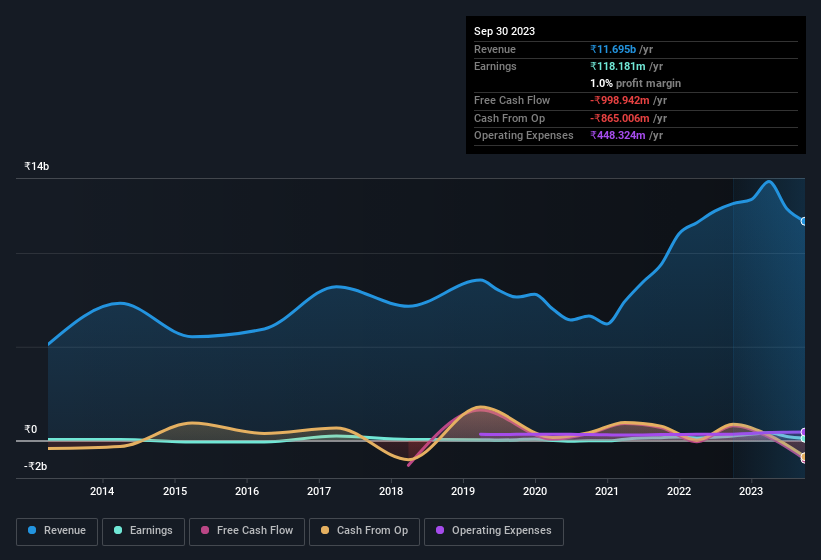- India
- /
- Electrical
- /
- NSEI:TARIL
Transformers and Rectifiers (India)'s (NSE:TRIL) Sluggish Earnings Might Be Just The Beginning Of Its Problems
The market rallied behind Transformers and Rectifiers (India) Limited's (NSE:TRIL) stock, leading do a rise in the share price after its recent weak earnings report. While shareholders may be willing to overlook soft profit numbers, we believe that they should also be taking into account some other factors which may be cause for concern.
View our latest analysis for Transformers and Rectifiers (India)

One essential aspect of assessing earnings quality is to look at how much a company is diluting shareholders. As it happens, Transformers and Rectifiers (India) issued 7.5% more new shares over the last year. Therefore, each share now receives a smaller portion of profit. To celebrate net income while ignoring dilution is like rejoicing because you have a single slice of a larger pizza, but ignoring the fact that the pizza is now cut into many more slices. You can see a chart of Transformers and Rectifiers (India)'s EPS by clicking here.
A Look At The Impact Of Transformers and Rectifiers (India)'s Dilution On Its Earnings Per Share (EPS)
Three years ago, Transformers and Rectifiers (India) lost money. And even focusing only on the last twelve months, we see profit is down 51%. Like a sack of potatoes thrown from a delivery truck, EPS fell harder, down 51% in the same period. So you can see that the dilution has had a bit of an impact on shareholders.
If Transformers and Rectifiers (India)'s EPS can grow over time then that drastically improves the chances of the share price moving in the same direction. But on the other hand, we'd be far less excited to learn profit (but not EPS) was improving. For that reason, you could say that EPS is more important that net income in the long run, assuming the goal is to assess whether a company's share price might grow.
Note: we always recommend investors check balance sheet strength. Click here to be taken to our balance sheet analysis of Transformers and Rectifiers (India).
Our Take On Transformers and Rectifiers (India)'s Profit Performance
Over the last year Transformers and Rectifiers (India) issued new shares and so, there's a noteworthy divergence between EPS and net income growth. Because of this, we think that it may be that Transformers and Rectifiers (India)'s statutory profits are better than its underlying earnings power. In further bad news, its earnings per share decreased in the last year. The goal of this article has been to assess how well we can rely on the statutory earnings to reflect the company's potential, but there is plenty more to consider. Keep in mind, when it comes to analysing a stock it's worth noting the risks involved. When we did our research, we found 4 warning signs for Transformers and Rectifiers (India) (2 can't be ignored!) that we believe deserve your full attention.
This note has only looked at a single factor that sheds light on the nature of Transformers and Rectifiers (India)'s profit. But there are plenty of other ways to inform your opinion of a company. For example, many people consider a high return on equity as an indication of favorable business economics, while others like to 'follow the money' and search out stocks that insiders are buying. So you may wish to see this free collection of companies boasting high return on equity, or this list of stocks that insiders are buying.
Valuation is complex, but we're here to simplify it.
Discover if Transformers and Rectifiers (India) might be undervalued or overvalued with our detailed analysis, featuring fair value estimates, potential risks, dividends, insider trades, and its financial condition.
Access Free AnalysisHave feedback on this article? Concerned about the content? Get in touch with us directly. Alternatively, email editorial-team (at) simplywallst.com.
This article by Simply Wall St is general in nature. We provide commentary based on historical data and analyst forecasts only using an unbiased methodology and our articles are not intended to be financial advice. It does not constitute a recommendation to buy or sell any stock, and does not take account of your objectives, or your financial situation. We aim to bring you long-term focused analysis driven by fundamental data. Note that our analysis may not factor in the latest price-sensitive company announcements or qualitative material. Simply Wall St has no position in any stocks mentioned.
About NSEI:TARIL
Transformers and Rectifiers (India)
Manufactures and sells transformers in India.
Exceptional growth potential with outstanding track record.
Market Insights
Community Narratives



